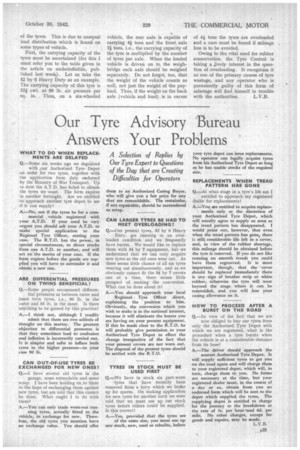Our Tyre Advisory Bureau Answers Your Problems
Page 25

If you've noticed an error in this article please click here to report it so we can fix it.
WHAT TO DO WHEN REPLACEMENTS ARE DELAYED
Q.—Some six weeks ago we deposited with sour Authorized Tyre Depot an order for two tyres, together with the application form duly endorsed by the Ministry of War Transport. Up to date the A.T.D. has failed to obtain the tyres we •want. The form expires in another fortnight. Are we entitled to approach another tyre depot to see if it can supply?
A.—No, not if the tyres be for a com
mercial , vehicle registered with your A.T.D. If your need be very urgent you should ask your A.T.D. to make special application to the Regional Tyre Officer, stating your case. The R.T.O. has the power, in special circumstances, to direct stocks from one A.T.D. to another, and will act on the merits of your case. If the form expires before the goods are supplied you will have to surrender it and obtain a new one.
ARE DIFFERENTIAL PRESSURES ON TWINS BENEFICIAL?
Q.—Some people recommend differen tial pressures as between outer and inner twin tyres, i.e., 90 lb. in the outer and 85 lb. in the inner. Is there anything to be gained by this practice?
A.—I think not, alth6ugh I readily
admit that there are two schools of thought on this matter. The greatest objection to differential pressures is that they sometimes lead to confusion and inflation is incorrectly carried out. It is simpler and safer to inflate both tyres to the higher pressure—in your case 90 lb.
CAN OUT-OF-USE TYRES BE EXCHANGED FOR NEW ONES?
Q.—I have several old tyres in the garage, some retreadable and some scrap. I have been holding on,to them in the hope of exchanging them against new tyres, but am told that this cannot be done. What ought I to do with them?
A.—You can only trade worn-out run ning tyres, actually fitted to the vehicle, in exchange for new. Therefore, the old tyres you mention have no exchange value. You should offer them to an Authorized Casing Buyer, who will give you a fair price for any that are remouldable. The remainder, if not repairable, should be surrendered as scrap.
dAN LARGER TYRES BE HAD TO MEET OVERLOADING?
Q.—Our present tyres, 32 by 6 Heavy Duty, are running in an overloaded condition and we frequently have bursts. We would like to replace them with 34 by 7 equipment, but we understand that we can only acquire new tyres as the old ones wear out. As there seems little chance of all six tyres wearing out simultaneously, and as we obviously cannot fit the 34 by 7 covers one at a time, there seems little prospect of making the conversion. What can be done about it?
A.—You should approach your local Regional Tyre Officer direct, explaining the position to him. Obviously, the conversion which you wish to make is in the national interest, because it will eliminate the bursts you are having on your present equipment. If this be made clear to the R.T.O. he will probably give permission, to your Authorized Tyre Depot to effect the change irrespective of the fact that your present covers are not worn out. The disposal of the present tyres should be settled with the R.T.O.
TYRES IN STOCK MUST BE USED FIRST
Q.—We have in stock six part-worn
tyres that have recently been removed from a lorry which we broke up for spares. On making application for new tyres for another lorry we were told that we must use up our stock tyres before others could be supplied. Is this correct?
A.—Yes, provided that the tyres are of the same size, you must use up any stock, new, used or rebuilts, before
your tyre depot can issue replacements. No operator can legally acquire tyres from his Authorized Tyre Depot so long as he has usable stocks of the required size.
REPLACEMENTS WHEN TREAD PATTERN HAS GONE
Q.—At what stage in a tyre's life am I entitled to approach my registered dealer for replacements?
A.—You are entitled to acquire replace
ments only at the discretion of your Authorized Tyre Depot, which will usually agree to supply so soon as the tread pattern has disappeared. I would point out, however, that even when the tread pattern has gone, there ii stilt considerable life left in a cover, and, in view of the rubber shortage, this mileage should be obtained before the tyre is removed. If you do not like running on smooth treads you could have them regrooved. It is most important, though, that the 'cover should be replaced immediately there is any sign of breaker strip or white rubber, otherwise the tyre will wear beyond the stage where it can be remoulded, and you will lose your casing allowance on it.
HOW TO PROCEED AFTER A BURST ON THE ROAD
Q..—In view of the fact that we are
now obliged to buy our tyres from only the Authorized Tyre Depot with which we are registered, what is the procedure when a tyre bursts when the vehicle is at a considerable distance from its base?
A.—The driver should approach the
nearest Authorized Tyre Depot. It will supply sufficient tyres to get you on the road again and will charge them to your registered depot, which will, in turn, charge them to you. No forms are necessary at the time, but your registered dealer must, in the course of a day or so, obtain from you an endorsed form which will be sent to the depot which supplied the tyres. The supplying depot is entitled to charge for the journey to the breakdown at the rate of 3s. per hour 'and 6d. per mile. No other charges, except for goods and repairs, may be made.




















































